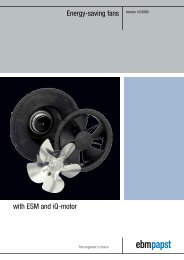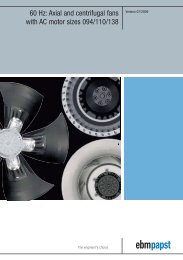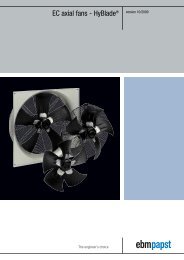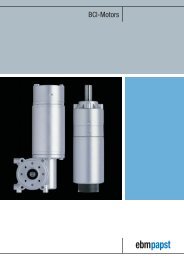Compact fans for AC and DC [PDF] - ebm-papst
Compact fans for AC and DC [PDF] - ebm-papst
Compact fans for AC and DC [PDF] - ebm-papst
- No tags were found...
Create successful ePaper yourself
Turn your PDF publications into a flip-book with our unique Google optimized e-Paper software.
Optional special versionsIn<strong>for</strong>mation on pictogramsOn the pages of the catalogue <strong>and</strong> on the following overview pages, the pictograms illustrated below provide in<strong>for</strong>mation about technically possiblespecial versions in the fan line presented.Please note that these special versions are not possible <strong>for</strong> all voltages <strong>and</strong> speeds, <strong>and</strong> not in all combinations.The special versions are designed <strong>for</strong> specific customers <strong>and</strong> projects <strong>and</strong> are not usually available off the shelf.N GSpeed signalThe fan uses a separate wire to output in<strong>for</strong>mationabout its speed, <strong>and</strong> thus about the speed of the rotor.For technical details, please refer to page 110.Go / No-go alarmThe fan uses a separate wire to output a static signalwhen it is stationary, thus providing in<strong>for</strong>mation aboutwhether or not the rotor is turning. For technicaldetails, please refer to page 117.PWMAPWM control inputThe speed of the fan can be changed via a pulse-widthmodulatedsignal. This signal is applied to a speciallyprovided wire. For technical details, please refer topage 121.Analogue control inputThe speed of the fan can be changed via a control voltage.This control voltage is applied to a specially providedwire. For technical details, please refer to page 121.Alarm with limit speedIf the speed drops below a certain level defined in thefan's electronics, the fan will emit a static signal, thusproviding in<strong>for</strong>mation about whether or not the rotor isturning. For technical details, please refer to page 114.Multi-option control inputThe fan has a control input that the user can trigger eitherusing a PWM signal, an analogue signal or aresistor. For technical details, please refer to page 122.TIExternal temperature sensorAn NTC is connected to the fan via a separate wire <strong>and</strong>the fan changes its speed depending on the temperatureat the NTC. For technical details, please refer topage 120.Internal temperature sensorIn this case, the NTC is integrated into the fan <strong>and</strong> thefan changes its speed depending on the temperature atthe NTC. For technical details, please refer to page120.HPIP54SPProtection against moistureProtection <strong>for</strong> the fan's electronics against moisture <strong>and</strong>condensation. For technical details, please refer topage 123.IP 54Protection of motor <strong>and</strong> PCB board against splashedwater <strong>and</strong> humidity. For technical details, please refer topage 123.Protection against salt spray fogProtection of fan against the damaging effects of saltspray fog. For technical details, please refer to page 123.20


![Compact fans for AC and DC [PDF] - ebm-papst](https://img.yumpu.com/48610592/20/500x640/compact-fans-for-ac-and-dc-pdf-ebm-papst.jpg)


![Download [PDF] 9.8 MB - ebm-papst Automotive & Drives](https://img.yumpu.com/47171334/1/184x260/download-pdf-98-mb-ebm-papst-automotive-drives.jpg?quality=85)

![Download [PDF] 3.1 MB - ebm-papst UK](https://img.yumpu.com/40847594/1/185x260/download-pdf-31-mb-ebm-papst-uk.jpg?quality=85)

![Download [PDF] 2.1 MB - ebm-papst UK](https://img.yumpu.com/36174834/1/190x247/download-pdf-21-mb-ebm-papst-uk.jpg?quality=85)
![Download [PDF] 2.3 MB - ebm-papst UK](https://img.yumpu.com/35271378/1/190x252/download-pdf-23-mb-ebm-papst-uk.jpg?quality=85)
![Download [PDF] - ebm-papst UK](https://img.yumpu.com/35139755/1/190x135/download-pdf-ebm-papst-uk.jpg?quality=85)

![Download [PDF] 1.5 MB - ebm-papst UK](https://img.yumpu.com/30021941/1/184x260/download-pdf-15-mb-ebm-papst-uk.jpg?quality=85)
![DC fans - specials [PDF] 1.2 MB](https://img.yumpu.com/28121898/1/184x260/dc-fans-specials-pdf-12-mb.jpg?quality=85)
